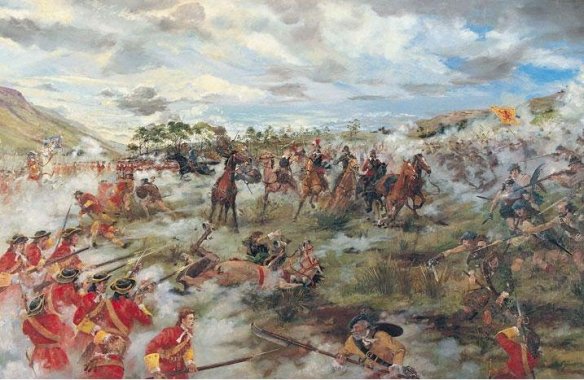Battle of Killiecrankie Pass
PRINCIPAL COMBATANTS: Scottish government forces (favoring William and Mary) vs. Jacobite rebels (favoring the restoration of James II)
PRINCIPAL THEATER(S): Scottish Highlands
DECLARATION: None
MAJOR ISSUES AND OBJECTIVES: The Jacobites sought to restore James II to the English throne, which was occupied by William and Mary.
OUTCOME: The rebellion was crushed.
APPROXIMATE MAXIMUM NUMBER OF MEN UNDER ARMS: Scottish government, 4,000; Jacobites, a lesser number
CASUALTIES: At Killiecrankie Pass, 2,000 government troops died in the single greatest loss of the war; throughout the rest of the war, losses among the Jacobites were heavy.
TREATIES: None
In 1688, the British Parliament invited William of Orange (1650–1702) to come from Holland and replace James II (1633–1701) as king of England. He did so in the GLORIOUS REVOLUTION of 1688, but a body of Tories and Stuarts rejected William and Mary II (1662–94) and were determined to restore James II to the throne. These Jacobites staged a rebellion in the Scottish Highlands, although James himself was off elsewhere, leading an army in the IRISH WAR (1689–91). Throughout most of Scotland, William and Mary had been accepted as Britain’s new monarchs, and Scots authorities sent troops to suppress the Jacobites. At Killiecrankie Pass, in the Grampian Mountains, on July 27, 1689, 4,000 government troops under General Hugh Mackay (c. 1640–92) were ambushed by a smaller Jacobite force led by John Graham (c. 1649–89), viscount Dundee. Dundee’s swift surprise attack killed half of Mackay’s men, but the brilliant Dundee fell in the attack, rendering this a Pyrrhic victory because, leaderless, the Jacobites dispersed.
The Jacobites reformed and attacked at Dunkeld but were this time severely beaten and retreated into the hills. In 1690, the Battle of Cromdale also proved disastrous to the Jacobites. In the meantime, on July 1, James’s forces were decisively defeated in Ireland at the Battle of the Boyne, and James fled to France, where he died in 1701 without again attempting to retake the English throne. Although William’s forces had prevailed in Scotland, the new monarchs were never able to win the full loyalty of the Highlanders.
Further reading: Leo Gooch, The Desperate Faction?: The Jacobites of North-East England, 1688–1745 (Hull, England: University of Hull Press, 1995); Bruce Lenman, The Jacobite Risings in Britain, 1689–1746 (London: Scottish Cultural Press, 1995.
